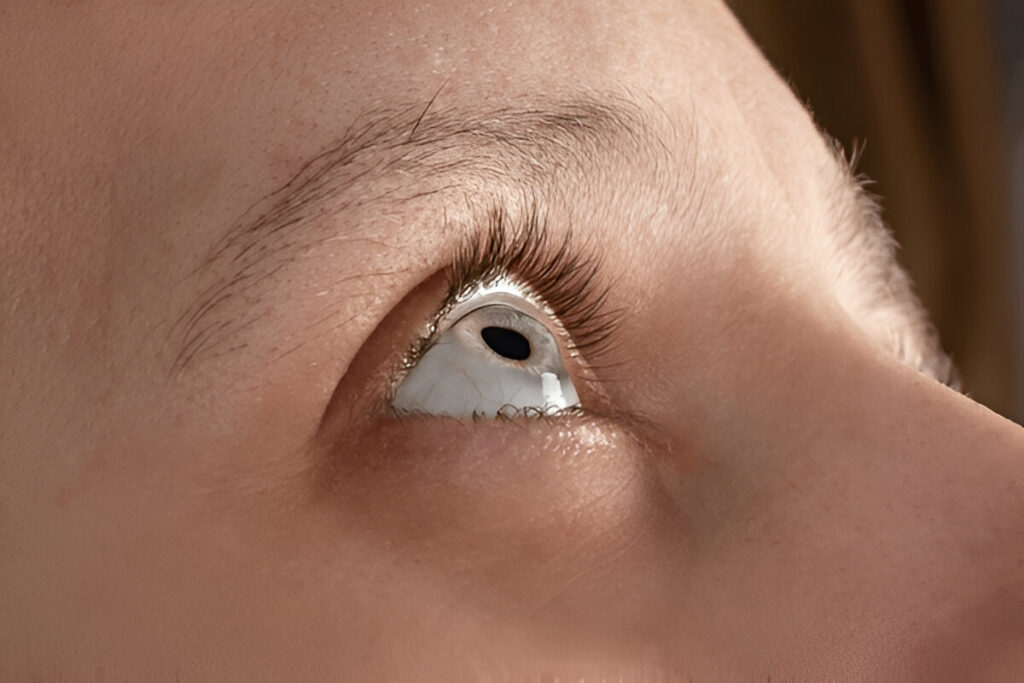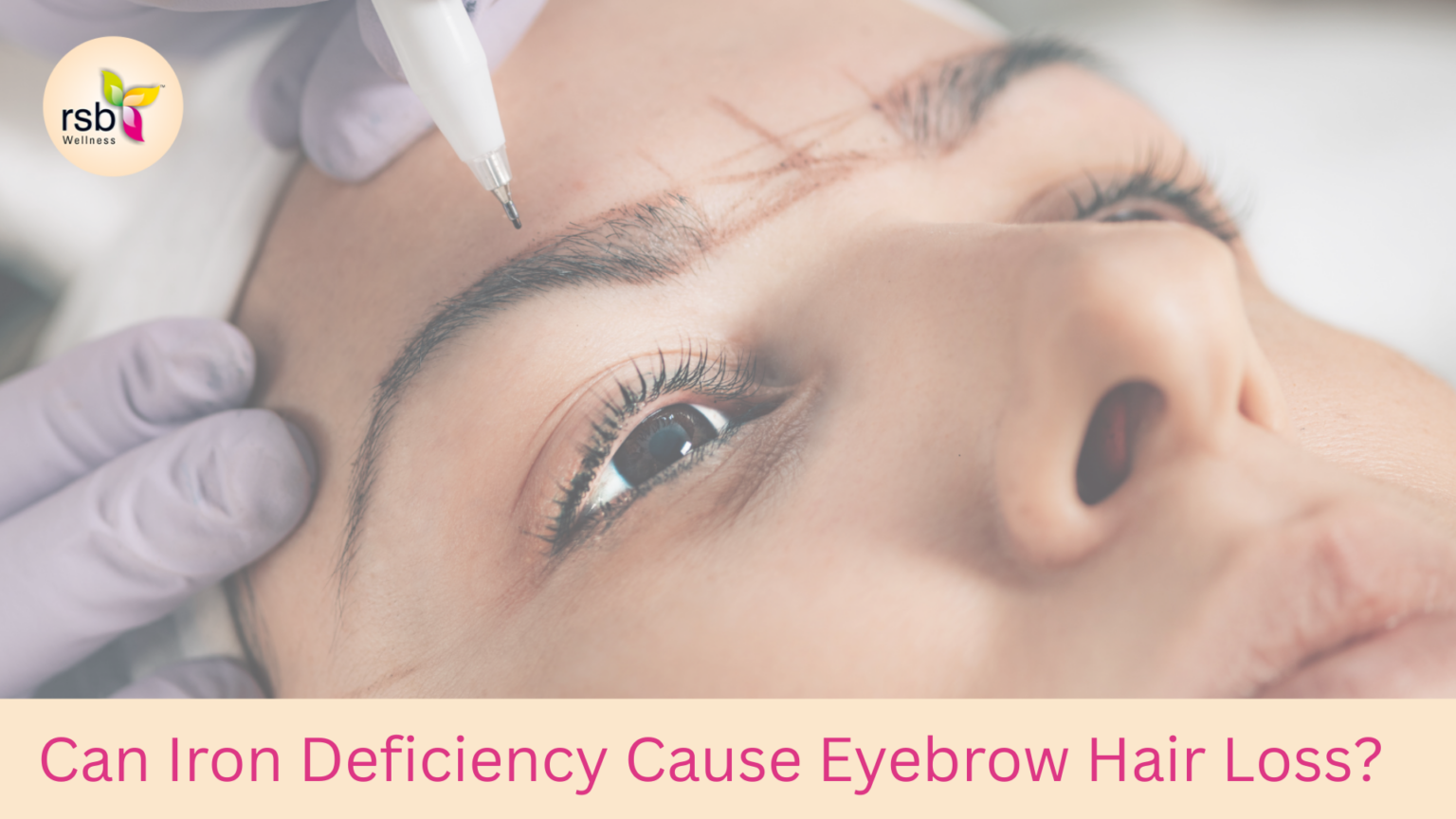Deficiency is a common health problem, especially in India. When your body does not have enough iron, it can lead to hair loss not just from your scalp, but from the eyebrows as well. Many people suffer from iron deficiency, especially women, due to poor diet, heavy periods, or pregnancy.
According to the global reports, around 30% of people worldwide and nearly 50% of Indian women between 15 to 49 years are affected by anemia.
Many people have a concern in their mind – Can Iron Deficiency Cause Eyebrow Hair Loss? In this blog, we will discuss how iron deficiency affects eyebrow hair and what you can do to treat it.
Can Iron Deficiency Cause Eyebrow Hair Loss?
Understanding the Link Between Iron Levels and Eyebrow Hair Loss
Iron is an important mineral that helps carry oxygen to your hair roots. Without enough iron, your hair follicles may become weak, leading to thinning or eyebrow hair loss.
This problem is often seen in women and young adults who may not realize that low iron could be the reason behind their hair concerns.
If your eyebrows are getting thinner without any clear reason, checking your iron levels might help you understand the root cause.
– Scientific Explanation of How Low Iron Impacts Hair Growth Cycles
Hair follows a natural growth cycle, but Low iron levels may push your hairs into the hair losing phase earlier. This imbalance leads to visible thinning of eyebrows and slows down regrowth.
– Signs That Suggest Iron-Deficiency-Related Eyebrow Loss
- Thinning from the outer edge of eyebrows
- Feeling tired or weak often
- Pale skin or brittle nails
- Slower regrowth of eyebrow hair
- Hair loss along with irregular periods or poor diet

Common Causes of Eyebrow Hair Loss
From Deficiencies to Hormones: Common Triggers of Eyebrow Hair Loss
Eyebrow hair loss can happen slowly or suddenly, and it often has more than one cause. Understanding the eyebrow hair loss causes behind thinning or patchy eyebrows can help you find the right treatment.
– Nutrient Deficiencies
Lack of essential nutrients like iron, biotin, and zinc can lead to eyebrow hair loss. These nutrients are important for healthy hair growth. When your body is low on them, hair follicles become weak and shedding begins.
– Hormonal Imbalances
Hormonal changes are another major cause. Thyroid problems (both hypothyroidism and hyperthyroidism) can cause eyebrow thinning, especially from the outer edges. Fluctuations in estrogen levels during pregnancy or menopause may also impact eyebrow growth.
– Skin Conditions
Skin issues like eczema, psoriasis, and seborrheic dermatitis can cause itching, flaking, and damage to hair follicles around the eyebrows, resulting in hair loss that’s why taking care of your skin is equally important.
Glow Without Filters
Why hide behind makeup when your skin can shine naturally? HydraFacial gives real, lasting results you’ll love to flaunt.
– Alopecia Areata
This autoimmune condition attacks hair follicles and can lead to sudden patchy eyebrow hair loss. It may affect both eyebrows and other areas of the body.
– Chronic Stress and Aging
Long-term stress affects hormonal balance and hair cycles, leading to thinning eyebrows. With age, hair naturally becomes finer and grows more slowly, including on the brows.
– Medications and Treatments
Certain medications like chemotherapy, antidepressants, or treatments for thyroid and skin disorders may also contribute to eyebrow hair loss.
If you’re noticing eyebrow thinning, understanding these causes can guide you toward the right care and recovery.
Can botox cause Eyebrow Hair Loss?
Is Your Botox Treatment Affecting Your Brows?
If you are wondering whether Botox can lead to eyebrow hair loss, it is rare, but there are reports linking it to temporary hair thinning near the brow area.
– Mechanism of Botox and Nearby Muscle Interactions
Botox works by relaxing the muscles beneath the skin to smooth wrinkles, especially around the forehead and brows. When injected near the eyebrow area, it may temporarily affect nearby muscles or slightly restrict blood flow.
– Rare but Reported Cases of Hair Thinning Around the Brow Area
Though extremely rare, some people have reported eyebrow hair thinning after Botox. These cases are usually mild and may be due to individual sensitivity or incorrect injection techniques.
– Difference Between Botox Side Effects vs. Natural Hair Loss
| Aspect | Botox Side Effects | Natural Hair Loss |
| Cause | Injection affecting nearby muscles or blood flow | Nutritional deficiencies, hormones, stress, aging |
| Onset | Appears shortly after Botox treatment | Gradual, over weeks or months |
| Recovery | Usually temporary and reversible | May need treatment or lifestyle changes |
Eyebrow Hair Loss on One Side
What One-Sided Eyebrow Hair Loss Could Mean
Noticing eyebrow hair loss on one side can feel strange and concerning, especially when the other brow looks normal. This condition often points to localized issues affecting just one area of the face.
– Local Skin Infections or Trauma
- Fungal infections, folliculitis, or minor skin injuries like burns and cuts can damage hair follicles on one eyebrow.
- This may result in patchy or complete hair loss on that specific side.
- Conditions like dermatitis or allergic reactions may also trigger localized shedding.
– Habitual Plucking or Pressure
- This uneven stress can lead to visible thinning or bald spots.
- Frequently plucking one eyebrow more than the other can weaken the hair roots over time.
- Constantly resting your face on your hand or wearing tight headwear (helmets, caps) may apply pressure on one side.

When to See a Doctor
Medical Warning Signs Behind Eyebrow Hair Loss
If you see that your eyebrow hair is suddenly falling out or eyebrow hair loss one side and growing back after a few weeks, or you have itching, redness, rashes, or feel tired all the time, don’t ignore it.
Sometimes, the cause could be something deeper like iron deficiency, thyroid issues, alopecia areata, or even a skin infection. A dermatologist or general doctor might suggest some blood tests or a scalp check to get to the root of the problem. Getting help early means you can start the right treatment and prevent further thinning.
Eyebrow Hair Loss Treatment
Proven Ways to Restore Your Eyebrow Hair
Losing eyebrow hair can feel frustrating, but the good news is there are effective treatments available. Depending on the underlying cause, treatments range from simple dietary fixes to advanced cosmetic options.
Here’s a breakdown of the most common eyebrow hair loss treatment approaches:
– Nutritional Correction
Nutritional correction is an effective and natural way to deal with eyebrow hair loss caused by iron deficiency.
- Iron Supplements (After Testing): If iron deficiency is confirmed through blood tests, your doctor may recommend iron supplements to help restore levels and support hair regrowth.
- Dietary Changes: Add iron-rich foods like spinach, lentils, red meat, and fortified cereals to your daily meals. These help rebuild your iron reserves naturally.
- Vitamin C Support: Consuming fruits like oranges, amla, or lemon water with meals enhances iron absorption in the body, aiding faster recovery.
– Treatments
If you’re dealing with thin or patchy eyebrows, cosmetic treatments can offer long-lasting results. From enhancing natural shape to restoring fullness, These methods are safe, effective, and customized to suit different brow needs.
Microblading for Thin Eyebrows
Microblading for Thin Eyebrows is a semi-permanent cosmetic procedure designed to enhance your appearance of thin or sparse eyebrows. Using a handheld tool with fine needles, technicians create hair-like strokes by depositing pigment into your skin’s upper layers.
This technique results in natural-looking, fuller brows that can last between 12 to 18 months, depending on skin type and aftercare.

Micropigmentation for Eyebrows
Micropigmentation for eyebrows involves the use of a digital machine to implant pigment into your skin, enhancing eyebrow shape and fullness. This technique is particularly beneficial for you if you’re suffering with alopecia, scarring, or want a more defined brow for better appearance.
The results are long-lasting, typically requiring touch-ups every 12 to 18 months to maintain color vibrancy and shape.
Book Your Free Expert Advice
Get personalized advice for eyebrow hair loss and iron deficiency
Eyebrow Tattooing Touch-Up Sessions (Semi-Permanent Makeup)
Touch-up sessions are essential for maintaining the appearance of semi-permanent eyebrow tattoos, such as microblading or micropigmentation. Over time, factors like skin regeneration, sun exposure, and lifestyle can cause pigment fading and shape alterations.
Typically scheduled 4–8 weeks after the initial procedure, these sessions allow technicians to refine the brow shape, adjust pigment saturation, and address any inconsistencies.
Conclusion
Understanding and Treating Eyebrow Hair Loss
Eyebrow hair loss can be distressing for you, especially when the cause isn’t obvious. While various factors may contribute to thinning brows, you may be wondering—can iron deficiency cause eyebrow hair loss? Yes, it can.
Low iron levels weaken your hair follicles, slow down the regrowth and leading to noticeable thinning, But, with the help of proper diagnosis and an iron-rich diet or supplements, this condition is often reversible.
However, if the loss is sudden, patchy, or affects only one eyebrow, it’s important to consult a doctor to rule out other medical conditions such as thyroid disorders or skin issues.
While you’re working on recovery, cosmetic options like Microblading and Micropigmentation can help restore your confidence. Timely treatment can help reverse thinning and bring back your natural brows
FAQs
Can Iron Deficiency Cause Eyebrow Hair Loss?
-
Can Iron Deficiency Cause Eyebrow Hair Loss?
Yes, iron deficiency can cause your eyebrow hair loss. Iron is essential for healthy hair growth. Without enough iron, hair follicles weaken, leading to thinning or shedding of eyebrow hair, especially in women and young adults.
-
How do I know if my eyebrow loss is due to iron deficiency?
Thinning eyebrows, especially at the outer edges, along with fatigue, pale skin, or brittle nails, could be a sign of low iron. A simple blood test can help confirm iron deficiency and guide proper treatment.
-
Can iron deficiency hair loss be reversed?
Yes, in most cases, iron deficiency-related eyebrow hair loss can be reversed. Once iron levels are corrected with supplements and diet, hair follicles recover, and eyebrow hair starts to grow back over time.
-
What foods help with iron deficiency and eyebrow growth?
Foods like spinach, lentils, red meat, tofu, and fortified cereals are rich in iron. Eating them regularly, along with vitamin C sources like oranges or lemon water, helps your body absorb iron better and support hair regrowth.
-
How long does it take to regrow eyebrows after treating iron deficiency?
Eyebrow hair regrowth takes time. After correcting iron levels, you may start seeing improvement in 6 to 8 weeks, but full regrowth can take 3 to 6 months depending on how severe the deficiency was.
-
Can botox cause eyebrow hair loss?
Botox rarely causes eyebrow hair loss. In some cases, incorrect injection or muscle relaxation near the brows may reduce blood flow temporarily, leading to mild thinning. However, this is uncommon and usually not permanent.
-
Is My Thyroid Condition To Blame for My Hair Loss?
Yes, thyroid disorders like hypothyroidism or hyperthyroidism can cause hair loss. Hormonal imbalance affects the hair growth cycle, leading to thinning or shedding. Treating the thyroid condition usually helps restore normal hair growth over time.

